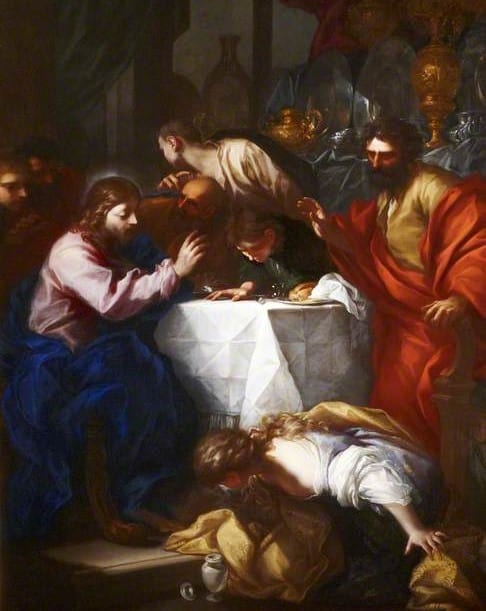
Christ and Mary Magdalene in the House of Simon, c. 1693
—Benedetto Lutti
Each year we begin our observance of Lent with the great penitential Psalm 51, which is the Responsorial Psalm for Ash Wednesday. The words of the Psalmist beg mercy for sin, but woven throughout is the imagery of cleansing or washing:
Cleanse me with hyssop, that I may be pure;
wash me, and I will be whiter than snow.
A clean heart create for me, God;
renew within me a steadfast spirit.
The three pillars of Lenten observance that the Church proposes to us are Prayer, Fasting, and Almsgiving. Each serves to cleanse our hearts of sin and the things that turn us away from God. The fruit of these observances is a conversion back to God (“convert” comes from the Latin convertere, “to turn back”), which for the Christian is a continuous and life-long process.
Christ exemplified these three observances during His ministry here on earth, and by participating in them each Lent we walk in His footsteps and live out our role as members of His body, the Church. Below are some suggestions to bring these Lenten observances to life in your schools and classrooms.
Prayer: The lifting up of the mind and heart to God
- Choose a special intention to pray for as a class or school and/or add opportunities for prayer to your schedule for the season of Lent (Adoration, Morning Prayer, the Divine Mercy Chaplet, decades of the Rosary throughout the day).
- If you don’t already have Confession built into your school calendar, consider adding a time during the school day or an evening Penance event for families at least once during Lent.
- Have each student record prayer intentions for a specific day of Lent and pray for them daily as a class.
- Have each class adopt a person or family within your community who needs prayers, or partner up with another class as prayer buddies for the season of Lent.
Fasting: The fasting and abstinence required by the Church during Lent pertains directly to food, but many people choose to give up other (legitimately good) things as an exercise in self-discipline and to make reparation for sin.
- Design a school-wide challenge for the Lenten season. This Screen Free challenge is a great way to work together as a community toward a common goal.
- Have your class pick something to fast from together for Lent. My students surprised me in the past with generous ideas like abstaining from meat or sweets at school one day each week besides Friday, waiting to go last in the pizza line, or drinking only water during one day each week.
Almsgiving: Donating money or goods to the poor and performing other acts of charity.
- Host a drive to collect items for a local charity: clothing, food, resources for a pregnancy center./span>
- Put together care packages and cards for those in nursing homes, the military, etc.
- Have your class pick a good deed to do (silently and discretely!) throughout Lent. Picking up trash, holding the door for others, and offering to help clean were favorites in my 6th grade class.
While Lent can seem long and arduous, working together as a community in its observance fosters bonds of charity and prepares our hearts and minds for the great celebrations of Holy Week and Easter.
[Originally published February 1, 2024]
